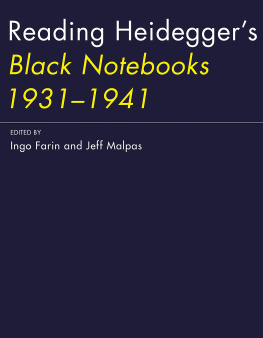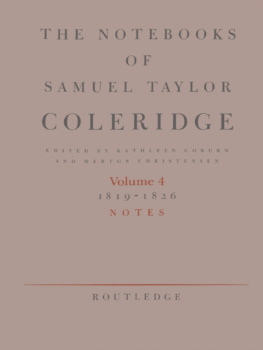Reading Heideggers Black Notebooks 19311941
Reading Heideggers Black Notebooks 19311941
edited by Ingo Farin and Jeff Malpas
The MIT Press
Cambridge, Massachusetts
London, England
2016 Massachusetts Institute of Technology
All rights reserved. No part of this book may be reproduced in any form by any electronic or mechanical means (including photocopying, recording, or information storage and retrieval) without permission in writing from the publisher.
Library of Congress Cataloging-in-Publication Data is available.
ISBN: 978-0-262-03401-2
EPUB Version 1.0
Contents
Ingo Farin and Jeff Malpas
Jeff Malpas
Fred Dallmayr
Steven Crowell
Gregory Fried
Babette Babich
Friedrich-Wilhelm von Herrmann
Jean Grondin
Laurence Paul Hemming
Daniela Vallega-Neu
Michael Fagenblat
Peter Trawny
Donatella Di Cesare
Holger Zaborowski
Karsten Harries
Tracy B. Strong
Thomas Rohkrmer
Andrew Bowie
Nancy A. Weston
Ingo Farin
Acknowledgments
Brought together relatively quickly in direct response to the controversy that emerged with the publication of the first volumes of Heideggers so-called Black Notebooks (Schwarze Hefte) in 2014, this has been a demanding volume to organize and produce. We are extremely grateful to all of our authors not only for agreeing to participate, but also for accommodating themselves so well to the tight schedule the project required. At the MIT Press, we would like to thank Philip Laughlin for seeing the worth of the volume and giving such strong support to its publication, and Judith Feldmann and Elizabeth Judd for their work in preparing the typescript for publication (thanks all the more deserved given the complexity of the material and the range of authors). We also would like to thank Adrian Staples for proofreading the volume and putting together the index. In addition, Ingo Farin would like to thank the Deutsche Literaturarchiv at Marbach for permission to see and read Heideggers Schwarze Hefte in the original. Finally, we are also grateful to the Los Angeles Review of Books and the Journal for Cultural and Religious Theory for allowing Gregory Fried and Michael Fagenblat to make use of previously published material from those journals in their contributions here.
Introduction
Ingo Farin and Jeff Malpas
The first series of Heideggers so-called Black Notebooks, spanning the years from 1931 to 1941, were released in three volumes (94, 95, and 96) of the Gesamtausgabe in the spring of 2014. These three book volumes contain the transcripts of fourteen individual volumes of notebooks, numbered IIXV by Heidegger himself. The first volume of the notebooks is missing and may have been destroyed by him. Heidegger gave titles to the individual notebooks, using the simple title berlegungen or Considerations for the notebooks from the third to the fifteenth, the more cumbersome title Winke X und berlegungen II und Anweisungen, or Hints X and Considerations II and Instructions, for the second notebook, and berlegungen und Winke III, or Considerations and Hints III, for the third notebook.
Heidegger continued the practice of writing notebooks after 1941, and so there are many more extant notebooks than just those that make up the berlegungen. It is believed that he wrote thirty-four or thirty-six notebooks in all, of which the last were composed in the early 1970s. All of the additional notebooks are currently held (as are the original notebooks that make up the berlegungen) in the Heidegger Archives at the Deutsche Literaturarchiv in Marbach, Germany, and all are scheduled for publication in forthcoming volumes of the Gesamtausgabe in the near future. The first of these, containing the notebooks Anmerkungen IV(Schwarze Hefte 19421948), has already appeared, in March 2015, as volume 97 in the Gesamtausgabe. This volume also contains an individual notebook that was found only after the publication of the first three volumes in 2014.
It has become customary to refer to these notebooks in general as the Black Notebooks after the black oilcloth booklets into which Heidegger originally transcribed his thoughts. But while this generic title has some practical advantages, it must not be forgotten that Heidegger put great care into distinguishing them from one anothersomething reflected in his practice of titling each notebook individually. Moreover, because the Black Notebooks encompass some thirty-four notebooks written over a period of forty years, it is prudent to refer to individual notebooks or sets of notebooks whenever possible. For this reason, we refer to the first of the now published sets of notebooks, those that span the years 1931 to 1941 (the years that appear in the title of this volume), by using the title Heidegger chose for themberlegungen or Considerationswhile we use the common name Black Notebooks only when talking about the entire collection of extant notebooks. Although not all of our authors consistently follow this practice, the fact that, for the most part, the only published volumes available at the time they were writing, and the volumes that have provoked the initial controversy surrounding the Black Notebooks, were the berlegungen means that most references to the Notebooks in the contributions here can be taken as being to the berlegungen unless otherwise noted.
The publication of the berlegungen, and the material the volumes contain, has provoked an enormous controversy that extends well beyond the confines of academic philosophy. That Heidegger was an enthusiastic supporter of the Nazi Party during the early 1930s is well known. However, the Notebooks not only provide further evidence of the extent of that enthusiasm, as well as demonstrating Heideggers increasing estrangement from National Socialism (however one interprets this) after 1934, but they contain a number of anti-Semitic passages. Moreover, those passages come almost entirely from the later volumes of the berlegungen, at a time when Heidegger had become deeply critical of Nazism, a point that itself raises questions about the relation between Heideggers Nazism and his anti-Semitism.
Since Heidegger is undoubtedly one of the most influential thinkers of the twentieth century, and a thinker who continues to be a major influence on contemporary thought, the material the Notebooks contain has led to much controversy over their relevance to our understanding and assessment of Heideggers philosophy. The editor of the Notebooks, Peter Trawny, has argued that the Notebooks show anti-Semitism as contaminating Heideggers philosophical thought.
The discussion that has swirled around the Notebooks so far has been further complicated by several other developments. The resignation of Gnter Figal from the presidency of the Heidegger-Gesellschaft on the grounds, as he put it, that after the new revelations in the Black Notebooks, especially the anti-Semitic passages, he could no longer function as a representative of Heideggers thought, added to the level of controversy. Whatever one may think of Klostermanns unparalleled reaction to the discovery of the error, Heidegger researchers are now also faced with the problem of potentially corrupt texts in the Gesamtausgabe. It is thus understandable that more and more researchers are demanding that the Heidegger Archives be opened to unrestricted scholarly scrutiny.



![Heidegger Martin - Ponderings. [1]: Black notebooks: Ponderings II-VI: black notebooks 1931-1938](/uploads/posts/book/212464/thumbs/heidegger-martin-ponderings-1-black.jpg)








